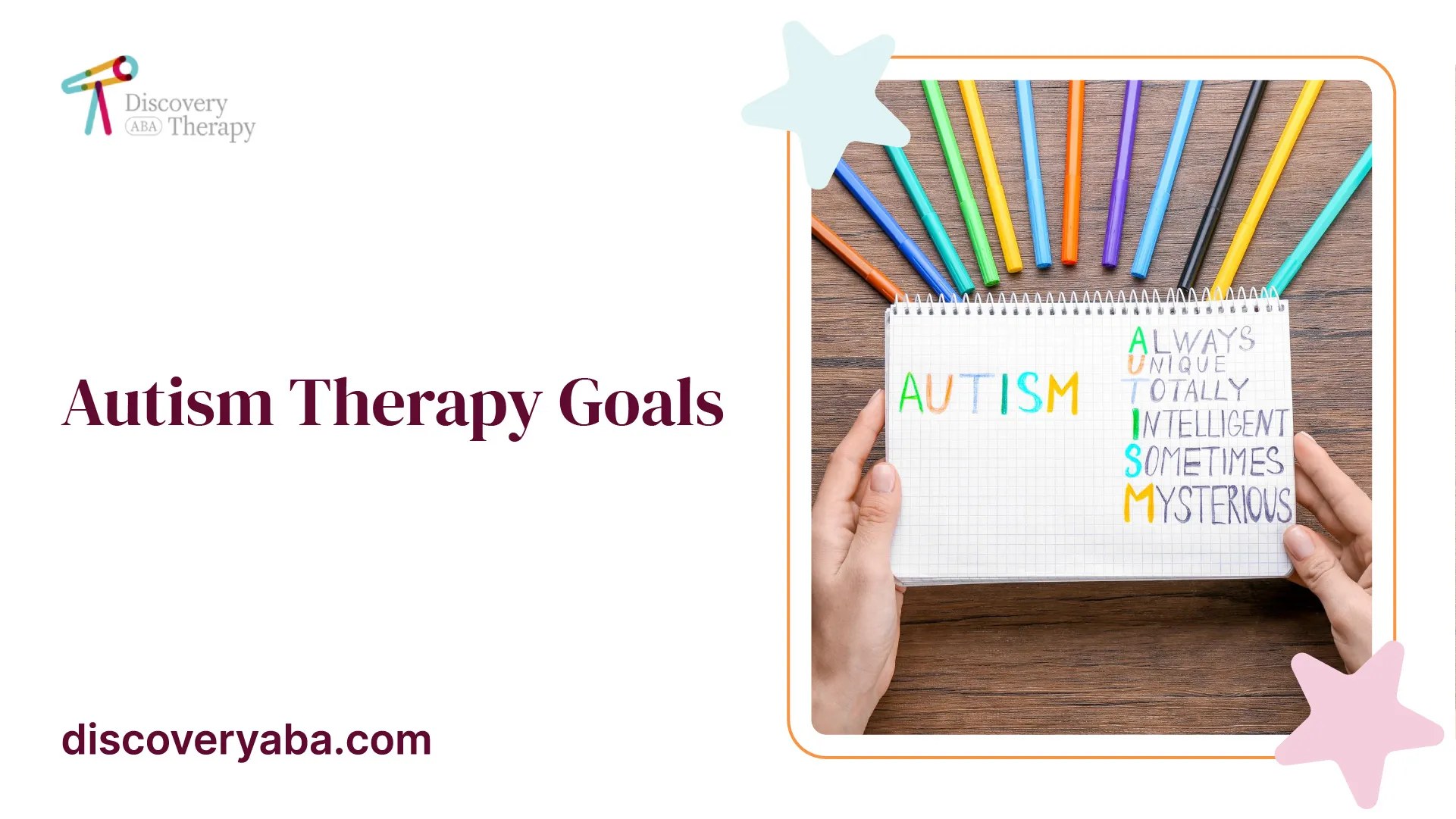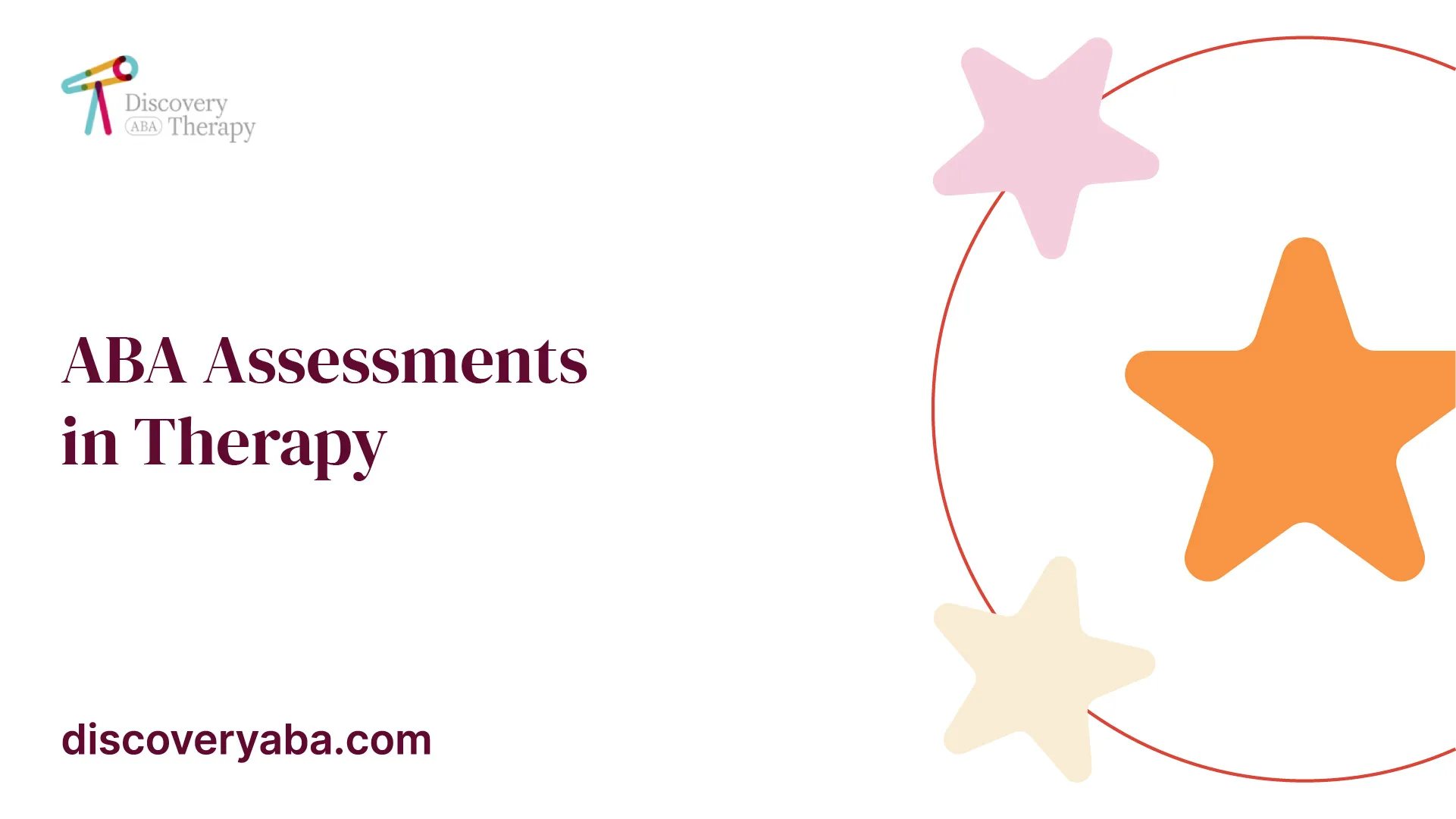Autism Therapy Goals
Explore autism therapy goals to empower progress and support individuals with tailored strategies and measurable success.

Importance of Therapy Goals

Empowering Individuals with Autism
Setting therapy goals is crucial as they provide a clear direction for therapy sessions and help track progress. They empower individuals with autism by involving them in the goal-setting process, which fosters a collaborative therapeutic relationship and promotes autonomy [1]. Additionally, therapy goals serve to improve specific skills such as communication and social interactions, ultimately leading to functional independence and an enhanced quality of life [1].
Therapy goals can include milestones that focus on various areas of development—like social skills, self-regulation, and communication. Here is a sample table showcasing common therapy goals:
Goal AreaExample GoalCommunicationImprove expressive language skills by using full sentencesSocial InteractionEngage in two social exchanges with peers during activitiesSelf-RegulationUse calming strategies independently during anxiety-inducing situationsFunctional IndependenceComplete daily living tasks with minimal prompts
Structured Progress Tracking
Progress tracking is a fundamental component of effective therapy. It drives many aspects of therapy from goal planning to demonstrating effectiveness. Consistent use of target metrics provides an objective record of the individual’s improvement throughout the therapeutic journey.
Goal tracking sheets are vital in ABA progress monitoring practice. These sheets create a comprehensive record of milestones achieved, interventions utilized, weekly progress notes, and mastery criteria for each goal.
To effectively monitor progress, families and caregivers can implement the following strategies:
StrategyDescriptionWeekly Review SessionsRegularly discuss progress towards goals with therapistsVisual TrackingUse charts or graphs to visually represent progressCelebrate AchievementsAcknowledge small successes to encourage motivation
By implementing structured tracking methods, caregivers can more effectively support individuals with autism on their journey toward reaching their therapy goals. For further insights, explore our page on autism therapy best practices.

Effective Therapy Goal Setting1
Setting effective therapy goals is crucial for supporting individuals with autism. These goals provide direction for therapy, enhance motivation, and help monitor progress. This section discusses how to create specific and measurable goals, ensure objectives are realistic and attainable, and implement time-bound targets.
Specific and Measurable Goals
Specific and measurable goals are essential for providing clarity in therapy. These goals should clearly define what the individual aims to achieve. For example, instead of stating "improve communication skills," a specific goal could be "increase the number of spontaneous utterances from 5 to 10 per session." Being measurable allows families and caregivers to track progress effectively.
Goal TypeExampleCommunication SkillIncrease spontaneous utterances from 5 to 10 per session.Social InteractionParticipate in a group activity for at least 15 minutes without prompts.
These structured goals help individuals with autism build skills like communication and social interactions, promoting functional independence and a better quality of life [1].
Realistic and Attainable Objectives
It is important that therapy objectives are realistic and attainable for individuals with autism. Considering the individual's current abilities is essential to avoid feelings of frustration or failure. Goals should foster a sense of achievement without overwhelming them. For example, if a child typically engages in a task for 5 minutes, an attainable goal could be extending this time to 8 minutes.
Objective TypeCurrent AbilityAttainable GoalTask Engagement5 minutes8 minutesSocial InteractionOne peer for 5 minutesTwo peers for 7 minutes
Setting these types of objectives encourages growth and development while ensuring that individuals remain motivated [1].
Time-Bound Targets
Time-bound targets are essential in autism therapy. These targets create a sense of urgency and provide a clear timeline for achieving desired outcomes. By aligning these targets with the individual's developmental pace, caregivers can monitor their progress more effectively. For instance, setting a target to reach a certain communication goal in three months allows for specific checkpoints.
Target TypeGoalTime FrameCommunicationUse 50 new words3 monthsSocial SkillsMake a new friend2 months
Having time-bound targets not only emphasizes accountability but also helps measure the success of therapy efforts [1]. Caregivers can adjust plans as necessary based on progress, ensuring that goals remain relevant and effective.
Setting effective therapy goals is fundamental in the autism treatment process. By focusing on specific, measurable, realistic, and time-bound objectives, families and caregivers can significantly enhance the therapeutic experience and overall outcomes for individuals with autism. For more information about autism therapy, consider checking out our article on autism therapy best practices.

ABA Assessments in Therapy2
ABA (Applied Behavior Analysis) assessments are essential in formulating effective therapy goals for individuals with autism. These assessments focus on understanding each individual’s unique strengths and areas for improvement, which guide the creation of personalized treatment plans tailored to their specific needs.
Personalized Treatment Plans
Personalized treatment plans are developed based on insights gained from ABA assessments. These plans consider the individual's unique abilities and challenges, facilitating targeted interventions. By focusing on specific deficits or skills, caregivers and therapists can create a roadmap to help individuals with autism progress. Each plan includes defined goals that are customized to the individual's requirements.
Components of a Personalized Treatment Plan
ComponentDescriptionGoalsIdentified based on assessment outcomesInterventionsTailored strategies designed to meet those goalsProgress MonitoringContinuous tracking via goal tracking sheetsReviewRegular assessments to adjust the plan as needed
Regular evaluations ensure that treatment strategies remain effective and modifications are made based on the individual’s progress.
Guiding Development and Progress
Guiding development involves consistent monitoring and evaluation of an individual’s progress in therapy. Regular assessments help measure the effectiveness of interventions and provide insights that inform future decision-making.
To facilitate progress, several methods are utilized:
By consistently gathering data through both structured and informal assessments, caregivers can gauge developmental gains and adapt strategies accordingly.
Measuring success in ABA therapy involves the establishment of specific short-term objectives that concentrate on essential skill and behavior development. Achieving these short-term objectives is crucial, as they form the groundwork for reaching long-term goals. For comprehensive strategies regarding autism therapy, refer to our article on autism therapy best practices.
Strategies in ABA Therapy
Applied Behavior Analysis (ABA) therapy employs various strategies to facilitate skill development and behavioral improvements for individuals with autism. Two key approaches are positive reinforcement techniques and skill development methodologies.
Positive Reinforcement Techniques
Positive reinforcement is a foundational technique in ABA therapy. It involves providing rewards or incentives to encourage desired behaviors. This approach is based on the principle that behaviors followed by positive outcomes are likely to be repeated. Common forms of reinforcement include verbal praise, tokens, or tangible rewards.
Type of ReinforcementExampleVerbal Praise"Great job using your words!"TokensEarning tokens for completing tasks, which can be exchanged for a reward.Tangible RewardsGetting a favorite toy or treat for demonstrating positive behavior.
Research indicates that utilizing positive reinforcement can lead to significant improvements in behavior and skill acquisition for individuals with autism. Families and caregivers are encouraged to identify and use specific reinforcements that resonate with the individual to maximize effectiveness.
Skill Development Approaches
Skill development in ABA is structured around breaking down complex skills into smaller, manageable components. This allows individuals to build on existing knowledge while learning new skills. Personalized treatment goals are created based on the individual’s unique strengths, preferences, and family input.
Some common skill development approaches used in ABA therapy include:
These methods not only enhance learning but also support confidence and independence [4]. For families, employing these strategies consistently can yield positive results in their loved one’s therapy journey.
For further insights into effective autism therapies and best practices, consider exploring our resources on autism therapy best practices and virtual reality in autism therapy.
Measuring Success in ABA Therapy
Measuring success in ABA therapy is crucial for understanding the effectiveness of interventions and making informed adjustments to treatment plans. Two key components in this evaluation process are short-term objectives and progress assessment techniques.
Short-term Objectives
Short-term objectives serve as stepping stones toward achieving broader therapy goals. These goals are specific and time-sensitive, making them easier to measure and assess. For example, a short-term objective might focus on improving social interaction skills. A specific goal could be for the individual to initiate and maintain a conversation with a peer for at least five minutes.
Short-term ObjectiveDescriptionCommunicationInitiate and maintain a conversation for five minutes.Social SkillsParticipate in a group activity with peers for at least 15 minutes.Self-RegulationFollow a calming technique when feeling overwhelmed in 80% of situations.
These short-term objectives help to create clear pathways to long-term success. They allow caregivers and therapists to track progress effectively and adjust strategies as needed.
Progress Assessment Techniques
Assessing progress in ABA therapy involves several techniques designed to provide objective data. Regular assessments are essential, as they help to identify areas of improvement, measure the effectiveness of interventions, and support data-driven decisions regarding treatment.
One common assessment method is the use of goal tracking sheets. These sheets serve as comprehensive records that document progress toward goal mastery. They include details such as priority goals, the interventions being used, weekly progress notes, and mastery criteria [Westside Children's Therapy].
Assessment TechniqueDescriptionGoal Tracking SheetsDocument progress, intervention techniques, and notes.Data CollectionGather quantifiable data through observations and reports.Regular AssessmentsConduct evaluations to reassess goals and adjust treatment accordingly.
This structured approach to progress assessment is a pillar of effective therapy that drives goal planning and showcases evidence of effectiveness. By consistently using these metrics, families and caregivers can gain a clear picture of the individual's improvement throughout their therapeutic journey. For more insights on autism therapy, check our section on autism therapy best practices.
Individualized Treatment Plans
Individualized treatment plans are essential in providing targeted and effective support for individuals with Autism Spectrum Disorder (ASD). These plans take into account the unique challenges faced by each individual, ensuring that interventions are specifically tailored to meet their diverse needs.
Tailoring Interventions
Tailoring interventions to the specific needs of individuals is crucial for addressing the unique challenges of those with autism. Professionals develop treatment plans that consider various factors, such as sensory sensitivities, communication abilities, and social interaction preferences. Such tailored approaches ensure that the support provided is not only relevant but effective in promoting positive outcomes.
Factors Considered in Tailoring InterventionsExamplesSensory SensitivitiesAdjusting environments to minimize sensory overloadCommunication AbilitiesIncorporating visual supports and augmentative communication toolsSocial Interaction PreferencesDeveloping individualized social skills training programs
Treatment plans often combine multiple interventions, including behavior therapy (such as ABA), speech therapy, occupational therapy, social skills training, and cognitive-behavioral therapy. These interventions aim to enhance communication, sensory integration, social interaction, and cognitive abilities, ultimately promoting overall functioning in individuals with autism.
Personalized Support Strategies
Personalized support strategies are integral to the success of individualized treatment plans. These strategies are designed to manage behavioral issues, improve social skills, and address co-occurring conditions such as anxiety and ADHD among individuals with autism [5].
When developing these strategies, professionals take into account each individual's background, abilities, and specific treatment goals. Personalized ABA therapy plans, for example, include detailed steps to achieve these goals and are highly customized based on the child's developmental milestones. This customization includes frequent progress monitoring, allowing adjustments to be made as needed to ensure effective outcomes [6].
In addition to behavioral interventions, incorporating therapeutic techniques that target communication, social skills, and behavioral skills is essential. Research indicates that initiating therapeutic interventions early in a child's development can significantly enhance outcomes, emphasizing the importance of timely support within the early years of life.
By tailoring interventions and implementing personalized support strategies, caregivers and professionals can effectively address the unique needs of individuals with autism. This approach lays the groundwork for meaningful progress and improved quality of life, ultimately contributing to the achievement of important therapy goals. For more information on effective support methods, check out our article on autism therapy best practices.
References
[2]:
[3]:
[4]:
[5]:
[6]:
[7]:
Does Your Child Have An Autism Diagnosis?
Learn More About How ABA Therapy Can Help
Find More Articles
Contact us
North Carolina, Nevada, Utah, Virginia
New Hampshire, Maine
Arizona, Colorado, Georgia, New Mexico, Oklahoma, Texas
.avif)




































































































